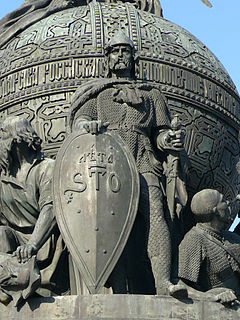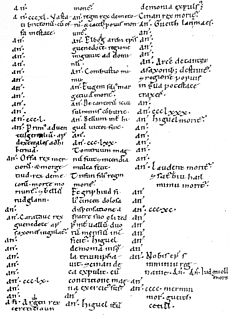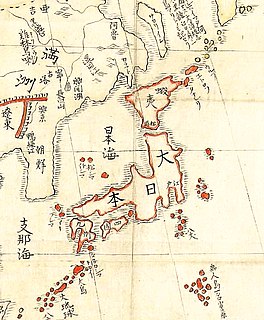A chronicle is a historical account of events arranged in chronological order, as in a time line. Typically, equal weight is given for historically important events and local events, the purpose being the recording of events that occurred, seen from the perspective of the chronicler. A chronicle which traces world history is a universal chronicle. This is in contrast to a narrative or history, in which an author chooses events to interpret and analyze and excludes those the author does not consider important or relevant.

Rurik, according to the 12th-century Primary Chronicle, was a Varangian chieftain of the Rus' who in the year 862 gained control of Ladoga, and built Novgorod in the same year. This legendary figure was considered by later rulers to be the founder of the Rurik dynasty, which ruled the Kievan Rus' and its successor states, including the Kingdom of Ruthenia, the Principality of Tver, Grand Duchy of Vladimir, the Grand Duchy of Moscow, the Novgorod Republic and the Tsardom of Russia, until the 17th century.

Louis II, sometimes called the Younger, was the king of Italy and Holy Roman Emperor from 844, co-ruling with his father Lothair I until 855, after which he ruled alone.

Annales Cambriae is the title given to a complex of Cambro-Latin chronicles compiled or derived from diverse sources at St David's in Dyfed, Wales. The earliest is a 12th-century presumed copy of a mid-10th century original; later editions were compiled in the 13th century. Despite the name, the Annales Cambriae record not only events in Wales, but also events in Ireland, Cornwall, England, Scotland and sometimes further afield, though the focus of the events recorded especially in the later two-thirds of the text is Wales.

Shōwa (正和) or Medieval Showa was a Japanese era name after Ōchō and before Bunpō. This period spanned the years from March 1312 through February 1317. The reigning emperor was Hanazono-tennō (花園天皇).
A number of Irish annals, of which the earliest was the Chronicle of Ireland, were compiled up to and shortly after the end of the 17th century.
The Battle of Leuven, also called the Battle of the Dyle, was fought in September 891 between East Francia and the Vikings. The existence of this battle is known due to several different chronicles, including the Annales Fuldenses and the Anglo-Saxon Chronicle. The Annales Fuldenses are royal chronicles of the East Frankish kingdom covering the years 714-901 AD. The Battle of the Dyle occurred near the present-day location of the city of Leuven in Belgium. In the 880s the Vikings established a camp there that they used as a base of operations from which to launch raids into the fractured Frankish kingdom. Efforts to verify the report of the battle from the Annales Fuldenses, specifically the huge loss of life on the Viking side, have been hindered by the lack of archaeological excavations in Belgium.
Romuald Guarna was the Archbishop of Salerno from 1153 to his death. He is remembered primarily for his Chronicon sive Annales, an important historical record of his time.

Lupus Protospatharius Barensis was the reputed author of the Chronicon rerum in regno Neapolitano gestarum, a concise history of the Mezzogiorno from 805 to 1102. He has only been named as the author since the seventeenth century. Lupus, along with two other Bariot chronicles, the Annales barenses and the Anonymi Barensis Chronicon, used some lost ancient annals of Bari up to 1051. William of Apulia appears to have used these same annals. Lupus also used the lost annals of Matera. Perhaps most unusual to Lupus is his dating method. He began his years in September and so places events of the latter half of a given year in the next year.
Marules was the Byzantine catepan of Italy in 1060/1061. Appointed by the Emperor Constantine X, he arrived in Bari between 1 September 1060 and 31 August 1061, according to the Anonymous Chronicle of Bari. He was the first catepan appointed after Argyros left Italy in 1058. He had been preceded in 1060 by a merarches, but the latter's offensive against the Normans had peaked before his arrival and he adopted a defensive posture.
Sirianus was the Byzantine catapan of Italy, the second appointed by the Emperor Constantine X Doukas. He arrived in Bari, the seat of the catapanate, in 1061 or 1062, replacing Marules, who had been appointed the previous year. Constantine was the last emperor who took an interest in recovering ground in Italy, but Sirianus was on the defensive against the Norman state and recovered no territory. According to the annals of Lupus Protospatharius, the Norman duke Robert Guiscard captured Oria and Brindisi in the year of his appointment and Taranto in the following year. He was succeeded in 1064 by Abulchares.

The Emirate of Bari was a short-lived Islamic state ruled by non-Arabs, probably Berbers and Black Africans. It was ruled from the south Italian city of Bari from 847 to 871. It was the most lasting episode in the history of Islam in peninsular southern Italy.
The Annales Paulini is an English medieval chronicle. The Chronicles of St Paul's, as the Annales Paulini might be translated, is thought to have been written by a canon of St Paul's Cathedral, London. Because it covers the period of 1307-1341 it is invaluable for the history of Edward II's reign. Adam Murimuth was a canon contemporaneously and originally from Oxford, thus intimating the author as his friend.

The Battle of Montemaggiore was fought on 4 May 1041, on the river Ofanto near Cannae in Byzantine Italy, between Lombard-Norman rebel forces and the Byzantine Empire. The Norman William Iron Arm led the offence, which was part of a greater revolt, against Michael Dokeianos, the Byzantine Catepan of Italy. Suffering heavy losses in the battle, the Byzantines were eventually defeated, and the remaining forces retreated to Bari. Dokeianos was replaced and transferred to Sicily as a result of the battle. The victory provided the Normans with increasing amounts of resources, as well as a renewed surge of knights joining the rebellion.
The Annales Altahenses was an early medieval royal annals compiled in the Niederaltaich Abbey which contains records of the events of almost all years in the period between 708 and 1073. In a tour de force of scholarship, Wilhelm von Giesebrecht published a Jahrbücher des Klosters Altaich (1841), reconstructing the lost Annales Altahenses, of which fragments only were then known to be extant, obscurely included within other chronicles. The brilliance of this performance was shown in 1867, when a copy of the original chronicle was found, and it was seen that Giesebrecht's text was substantially correct.
King of the Slavs was a title denoting some Slavic rulers, as well as Germanic rulers that conquered Slavs, in the Middle Ages in European sources, such as Papal correspondence.

Anonymi Barensis Chronicon is a medieval Italian annalistic chronicle.
Jaquinta was a queen consort of Dioclea by marriage to king Constantine Bodin. She is best known for her role in the Dioclean civil war, where she violently intervened in a succession crisis following the death of her husband, Constantine Bodin.
Bisantius Guirdeliku was a noble citizen of Bari, then the capital of the Byzantine catepanate of Italy. He held the rank of patrikios. During the siege of Bari (1068–71) by the Normans, he led the faction opposed to surrender until he was assassinated by his rival, Argirizzo, in 1070. His nickname is known from the anonymous Annales Barenses and the chronicle of Lupus Protospatharius.
Argyritzos was one of the leading citizens of Bari during the final years of Byzantine rule. He held the rank of protospatharios under the empire. His father was named Ioannakes.






